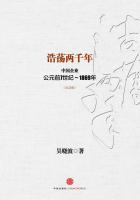3.Also,Buck found that the rental percentage was higher when the landowner provided part of the farming inputs(i.e.,the tenant cost was lower):
The percentage of total receipts for the landlord varies from 24.6 per cent,……where small rents are demanded to 66.6 per cent,……where the cropper system prevails and where the landlord furnishes everything but labor and routine management.[7]
Similarly,according to another survey conducted by Ching-Moh Chen in four provinces(China,1934),an average rental percent-age of 55.98 was found in tenant farms where landowners pro-vided seeds,fertilizers,and bullocks,as compared to an average of 46.37 percent when the tenants provided these nonland in-puts.[8]
Furthermore,given the production function,the land space rented to each tenant depends upon the fertility of land and the tenant's alternative earning.Specifically,the farm size per tenant family will be smaller if(a)the land is more fertile or(b)the ten-ant's alternative earning is loWer.[9] Again,supporting evidence is strong:
1.In Korea,the average farm size over a ten-year period(1929 through 1938)was 0.58 cho for paddy-field farms and 0.97 cho for dryland farms.In the same period and location,the prices of paddy fields were more than two and one-half times as high as those of dry fields,confirming that paddy fields were generally more fertile.[10]
2.According to another investigation conducted by Buck,which covers 16,786 sample farms in 168 localities in China(1929-33),we find(a)the average farm size in the more fertile rice region is 3.09 acres,as compared to an average size in the less fertile wheat region of 5.63 acres;and(b)of the seven types of crop fields listed,the smallest average size occurs in double-cropping rice fields(2.37 acres),which are generally most fertile.[11]
Turning to the tax-equivalent approach to analysis of share tenancy,and referring again to figure 5,we may well ask:If the asserted equilibrium at A were valid,what would we observe?The following is implied:
1.We would observe lower ratios of labor and other inputs to land in tenant farms than in farms under owner cultivation or in farms cultivated by hired farm hands.It also implies that hectare yields in tenant farms would be lower than in owner farms.But as Buck observed(China,1921—25):
Contrary to the prevailing opinion that tenants do not farm as well as owners,a classification according to yields by different types of tenure shows no significant variation in yields for most localities,and for the few in which a difference does occur,it is in favor of the tenant or part owner as often as for the owner……In some places,even,it is evident that the tenants farm better than the owners.[12]
Buck's data show the following crop indexes per acre:Owner farms,100 and 101;part-owner farms,99 and 101;and tenant farms,103 and 104.[13] Thirty years later,making no reference to Buck,James O.Bray echoed the same observation:
Underdeveloped countries intent on technical progress in agriculture should recognize the fact that much of the most impressive gain in agricultural productivity occurred in areas of the United States where the dominant form of land tenure is a share rental arrangement between landlord and tenant.[14]
With respect to the intensities of farming,we find Japanese data(1932-38)showing that the average landholding per owner farmer is 2.22 tan,as compared to 2.10 tan per part-owner farmer and 1.93 tan per tenant farmer,[15] also denying the implication of the tax approach.The higher labor-land ratio in tenant farms can be explained by the somewhat higher proportion of paddy fields under tenancy.
2.We would observe,since the rental earning is lower with equilibrium at A(under the tax approach),that the market value of land under tenant cultivation is less than the value of land under owner cultivation.Again,evidence clearly denies this implication.We find that the values of land differ according to fertility grades and locations,and that"the value of land for the three types of tenure(owner,part-owner,and tenant)in most cases varies only a few dollars."[16] Also,with equilibrium at A,we would observe that the actual rent received by the landowner is lower under share tenancy than under a fixed rent(rent per acre).As is shown in Appendix B,however,share rent is generally slightly higher than crop rent.[17] This slight difference,as I shall indicate later,might be explained as a payment to the landowner for his"risk"bearing under a share contract.
3.We would observe,as implied by the tax approach,that a higher rental percentage-with the
(1-r)curve shifting downward in figure 5—would be associated with less farming inputs per unit of land in tenant farms.We find evidence to the contrary:Tenant farms with higher rental percentages usually also display higher labor-land ratios.[18] This is due either to the land's being more fertile or to the tenants'alternative earnings'being lower,a condition implied by our theory of share tenancy.
4.Finally,if the tax-equivalent approach were correct,we would observe that most,if not all,share tenants would rent land from several landlords.But this is rarely the case.Take Taiwan,for example.In 1949 there existed only 1.24 leases per tenant family.[19] This extra.24 lease can easily be explained by the use of marginal plots as discussed in chapter 2.On the other hand,landowners issuing one or two hundred leases were regarded as common.[20]















